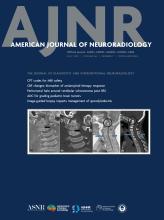This article requires a subscription to view the full text. If you have a subscription you may use the login form below to view the article. Access to this article can also be purchased.
Abstract
BACKGROUND AND PURPOSE: Cerebral small vessel disease (SVD) is a common cause of stroke and cognitive decline. SVD is characterized by white matter hyperintensities (WMH) and dilated perivascular spaces (PVS). While WMH can be associated with reduced CBF and glymphatic clearance, current clinical and radiologic assessments of these associations remain controversial and mostly qualitative. We aim to identify if arterial spin-labeling (ASL)-based CBF differences, particularly in the cortical surface at the GM/CSF interface, correlate with SVD severity.
MATERIALS AND METHODS: We performed a retrospective cohort study of healthy controls with normal cognition who underwent a brain MRI as part of our university’s Alzheimer Disease Research Center (ADRC) and an 15O-water PET study database. Our inclusion criteria included patients aged >50 years with no structural brain abnormalities besides SVD with ASL perfusion images. WMH grading was performed by using the Fazekas scale, WMH score, PVS grade, and manually segmented WMH volume. We identified patients with moderate-to-severe SVD and then selected age-matched samples of patients with minimal or no SVD. CBF of the whole brain (WB), GM, WM, and along the GM/CSF interface were calculated. Several perfusion metrics (WB, GM, and WM) as well as a novel perfusion metric, normalized GM/CSF interface (nGCI) perfusion metric, which indirectly reflects the relative ASL signal near the GM-CSF boundary, were evaluated by using receiver operating characteristic and correlation analyses.
RESULTS: Thirty-two patients met the inclusion criteria (n=11 moderate-to-severe SVD, mean age 72 ± 10 years, 6 women; n = 21 none-to-minimal SVD, mean age 70 ± 10 years, 12 women). Of the measured perfusion markers, nGCI had the strongest negative correlation with Fazekas score, total WMH volume, PVS grade, and average total SVD score (r = −0.68, −0.67, −0.54, −0.54, respectively; P < .001) as well as the highest area under the receiver operating characteristics curve (0.95, 95% CI: 0.87–1.0) as a predictor of WMH severity.
CONCLUSIONS: nGCI, a novel perfusion metric that may capture features of perfusion at the GM-CSF boundary, was strongly correlated with WMH and PVS severity. Further, longitudinal studies are required to determine the potential role of nGCI as a predictive marker of SVD progression.
ABBREVIATIONS:
- ADRC
- Alzheimer’s Disease Research Center
- ASL
- arterial spin-labeling
- nGCI
- normalized GM/CSF interface perfusion metric
- pcASL
- pseudocontinuous arterial spin-labeling
- PVS
- dilated perivascular space
- ROC
- receiver operating characteristics
- STRIVE
- Standards for Reporting Vascular Changes on Neuroimaging
- SVD
- small vessel disease
- WB
- whole brain
- WMH
- white matter hyperintensity
- © 2025 by American Journal of Neuroradiology












